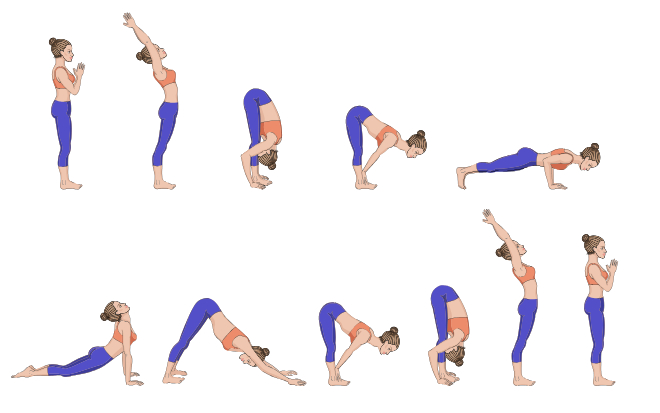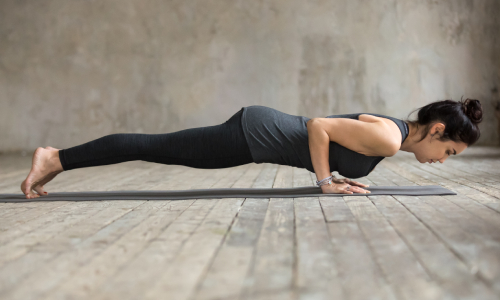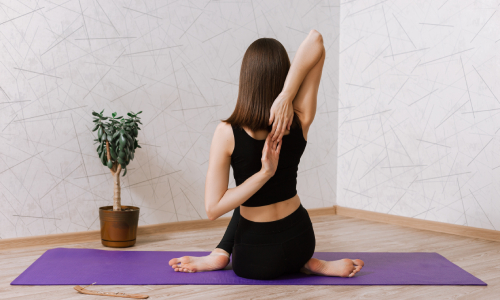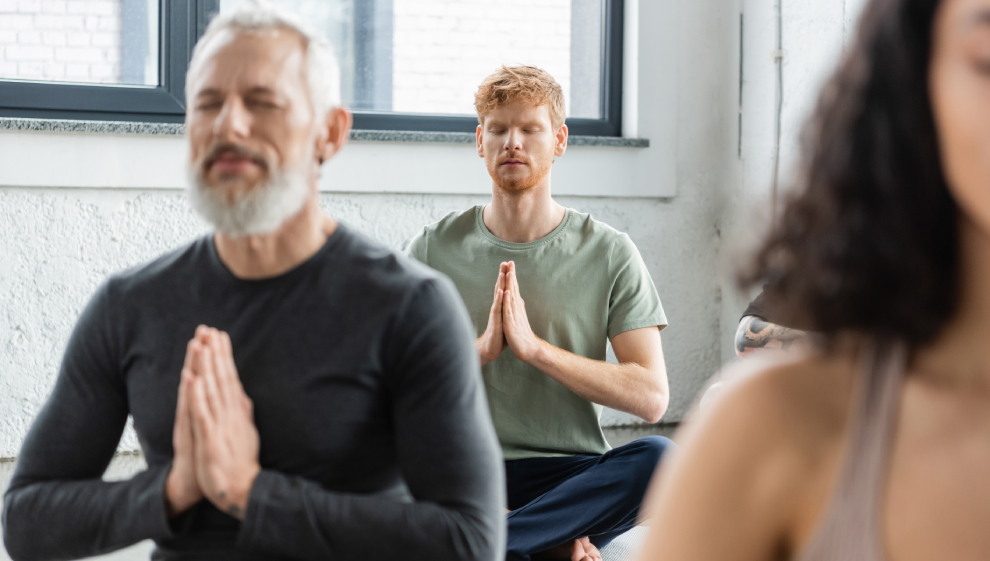Ten yoga terms you should know
1. Sun salutations / surya namaskars
In many types of yoga, near the beginning of the class you’ll go through a short sequence of poses that are repeated a few times. This is to warm up the body, mobilise the joints and start to allow meditative movement.
The most well-known are sun salutations A and B, which are part of the ashtanga series, and often feature in vinyasa classes. The following diagram shows sun salutation A and is as follows:

- Mountain pose
- Upward salute
- Forward fold
- Half lift
- Plank to chaturanga/knees-chest-chin
- Cobra/upward-facing dog
- Downward dog
- Half lift
- Forward fold
- Upward salute
- Mountain pose
You'll notice the first and last four poses mirror each other. The three poses in the middle – chaturanga to downward dog – are known as 'a vinyasa' (see below for definitions of chaturanga and vinyasa).
Sun salutation B expands on A by swapping the upward salute for chair pose and adds in warrior 1 on both sides with a vinyasa separating them.
2. Take a vinyasa
Vinyasa can refer to both a style of yoga (where one pose flows onto the next) and the name of a sequence of yoga poses.
In this context 'take a vinyasa' is the latter – it refers to the middle portion of a sun salutation from knees-chest-chin/chaturanga (read on for this definition), through cobra/upward-facing dog, and back into downward facing dog.
It’s often used after you’ve done a sequence on one side of the body to ‘reset’ before repeating the sequence on the other side (as seen in sun salutation B). This is an optional transition, so you can easily miss it out if you’re not feeling it!
3. Chaturanga (dandasana)

This is Sanskrit for 'four-limbed staff pose' and is a key pose in sun salutations as it takes you from plank to cobra or upward facing dog.
You can also push up from a supine position (lying on your front) through chaturanga, which is also known as a yoga push-up.
An easier variation of this pose is knees-chest-chin, which involves lowering those particular body parts down in that order, to give your arms and shoulders a rest.
4. Ujjayi breath
Ujjayi (pronounced oo-jai) is the most common type of pranayama. It translates as ‘victorious breath’ and is also known as ‘ocean breath’.
It involves taking a deep breath in through the nose and breathing out through your nose slowly while constricting your throat, so you sound like Darth Vader.
This type of breath can be used during a particularly taxing yoga poses to help you concentrate and find the energy to continue, or on its own as a breathing exercise or as part of meditation to help release tension and calm the mind.
5. Take a bind

A bind in yoga is whenever one body part holds on to another e.g. linking your hands behind your back in cow face pose (see image) or placing your hand around your waist in bound reverse warrior pose.
The benefit of binds is that they allow the muscles to release as you are supporting yourself.
Binds tend to be more advanced, so feel free to ignore when the teacher says “take a bind” if this option doesn’t work for your body.
6. Drishti
This is another word for ‘gaze’ so your teacher may say “drishti out to your middle finger” in warrior 2 pose. Drishti offers a point of focus to bring you into the moment.
There are set positions for the gaze in many poses. Here are the drishti points for the first seven poses in sun salutation A, for example:
- Mountain pose – soft gaze down
- Upward salute – thumb
- Forward fold – toes
- Half lift – third eye (the point on your forward between your eyes)
- Plank to chaturanga/knees-chest-chin – nose
- Cobra/upward-facing dog – nose
- Downward dog – navel.
7. Mudra

These are symbolic gestures – usually performed with the hands – the most well-known being ‘angali mudra’ or prayer hands, which represents balance and gratitude.
Another mudra is kali mudra, which involves creating a pistol shape with your hands. It's named after the goddess 'Kali' who is associated with strength, fearlessness and empowerment.
8. Om
Om – pronounced ah-uu-mm – acts as a marker of the beginning or end of a yoga class. Usually you’ll be sat cross-legged, hands in prayer position, and the teacher will invite you to take three ‘oms’.
You don’t have to do this if you don’t feel comfortable, but if you’re up for giving it a go – you breathe in through your nose to prepare, and then exhale chanting ‘om’ for as long as you can.
9. Savasana
Usually the final pose of the class, this pose involves lying down on your back and closing down the eyes.
The teacher may take you through a guided meditation or muscle relaxation sequence (or both if you’re lucky), as you soak up the benefits of the class and fully unwind.
10. Namaste
At the very end of a yoga class, your teacher may say ‘namaste’. This has many meanings, the most literal of which is ‘I bow to you’, but it can also mean ‘I honour you’ and ‘we are one’.
It’s used in this context to thank and respect each other for taking part in the yoga class together.
Want to learn more about yoga?
Read How to get started with yoga: a beginner's guide and The health benefits of yoga.
What to try some yoga?
We offer a range of yoga classes at our gyms, or we also have few free online yoga classes you can try.
Last updated Friday 18 August 2023
First published on Friday 18 August 2023

